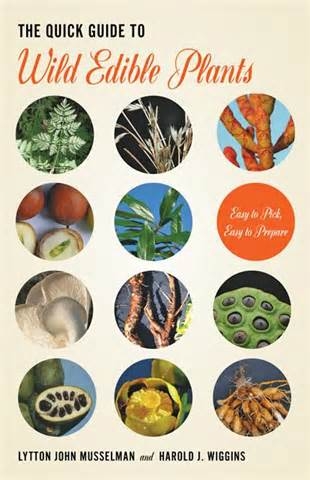Kudzu for Lunch? Musselman's New Book Is Guide to Wild Edibles
July 01, 2013
 Lytton Musselman
Lytton Musselman

Near the middle of the new book by Old Dominion University botanist Lytton John Musselman and his former student, Harold J. Wiggins, is a recipe for "Crunchy Kudzu Leaf Chips." It sums up what "The Quick Guide to Wild Edible Plants" is all about.
The book, published in June by the Johns Hopkins University Press, offers foraging-for-edibles instruction that is not only botanically sure-footed, but also practical and kitchen tested.
Musselman, an Eminent Professor and the Mary Payne Hogan Professor of Botany at ODU, and Wiggins, an environmental scientist with the Army Corps of Engineers, don't try in this 144-page book (with more than 100 color photos) to identify every edible plant or fungus growing in the United States, most of which the occasional forager would never come across, much less want to eat.
Their goal is to give their readers a realistic outdoors "shopping list" of abundant wild edibles in mid-Atlantic and northeastern states. To qualify for inclusion in the book, the authors say, the wild produce also had to be reasonably easy to prepare and taste good.
For example, the kudzu leaves for the chips mentioned above are certainly abundant. The book notes that many people consider kudzu an invasive weed. (It was brought to the United States from Japan and China in the late 1800s.) But the plant's reputation improves when you pick the tender leaves, dip them in an egg and flour batter and fry them in olive oil till they are golden brown. "Of the wild plants we have tried, we think kudzu is the best for frying," the authors write.
Following guidance in the book, you could gather river oats, use them to make a dough and then cut the dough into pasta strips. Perhaps then you could sauté the oyster mushrooms you have cut from a tree trunk to make a pasta sauce, or a mush up the pawpaws you have plucked from a tree limb to make your bread for the meal.
Altogether, the book has entries on 50 wild edibles organized into the categories of condiments (field garlic), greens (stinging nettle), starches (American lotus), grains (manna grass), flowers (orange day lily), sweets (Indian strawberry) and mushrooms (chicken of the woods). There are also sections on aperitif and digestive drinks made by steeping botanicals in alcohol spirits.
Recipes, all tested by the authors, number 36.
"The book was my idea based on almost half a century of teaching about edible wild plants - nibbling, munching, squeezing, chewing my way through the landscape, and no undergraduates were harmed in the process," Musselman said with a smile. "I have never been a great fan of most edible wild plant books because so often the main ingredients were not the plants but the adjuncts. To exaggerate - a recipe may take wild greens and add cream, butter, and wine. Of course it will taste good! This book is all about the plants, knowing them in a different way, experiencing the variety of basic flavors, which are not always what our palates like best, but perhaps should."
Musselman and Wiggins, who spent three years working on the book, point out in their introduction that ingesting wild plants can be dangerous. "First and foremost, the plants (named in the book as edible) are easy to identify and do not have any toxic look-alikes," they write.
But to lend weight to their warning, they offer a first chapter that is titled "Deadly Harvest: Plants You Should Avoid." It has text and photographs to keep readers away from harmful or potentially deadly plants ranging from poison oak to poison hemlock.
Although the 50 edibles featured are very common, according to the authors, many are "underutilized" as foods.
On the other hand, the authors state, they found some wild botanicals described as edible in historical texts to be either nasty tasting or too much trouble to gather and prepare for the table.
White water lilies, for example, are reputed to have been harvested for the nutritious starch that comes from their rhizomes and for their delicious flowers. "The image of this lovely, fragrant ornament of fresh water, however, belies the awful taste of its parts," the authors write. "White Water Lily has flinty, lacerating tannins. Same for the buds. ... Since native plants can vary widely in the concentration of chemical constituents, we repeated these trials with plants from North Carolina, Virginia and New York. No change in the horrid taste."
The authors claim that they were unable to evaluate the taste of another legendary edible, lichens, because they found it impossible to remove the sand that gets stuck in them.
"We believe that it is vital to mention failures in our book because it is an important way to learn about foraging and trying new recipes. ... It is our hope that our readers will learn from our experiences and find their own recipes from nature!"
A review from Publishers Weekly also notes the utility of the book's content: "The authors have put considerable work into discovering plants with enough edible content to make them worthwhile to collect and eat."
Musselman, a longtime friend of "The Prairie Home Companion" host Garrison Keillor, gets a jacket endorsement from the humorist: "Dr. Musselman is a passionate botanist. Walking among plant life makes him very happy, which means he is happy most of the time."
An ODU faculty member for nearly 40 years, Musselman teamed with another ODU alumnus and Army Corps environmental scientist, David Knepper, to produce the field guide "Plants of the Chesapeake Bay," which was published last year by The Johns Hopkins University Press.
Musselman also is an expert on the plants of biblical lands. His "Dictionary of Bible Plants" was published in 2011 by Cambridge University Press. He is the author of "Figs, Dates, Laurel, and Myrrh: Plants of the Bible and the Quran" (2007, Timber Press) and "Jordan in Bloom - Wildflowers of the Holy Land" (2000), commissioned by Queen Rania Al-Abdullah of Jordan.
Wiggins, who is assigned to the Army Corps field office in Fredericksburg, Va., is co-founder of the Fredericksburg chapter of the Virginia Native Plant Society. He is the author of three books, including "Virginia Native Plants" and "Virginia Wetlands Plants."

